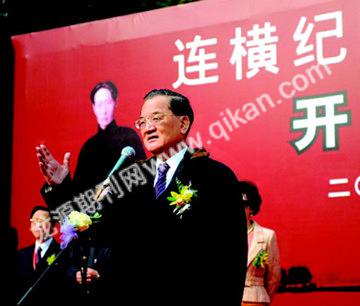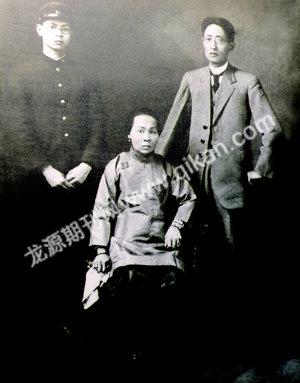Lian Heng and Agate Temple in Hangzhou
2009-06-30ZhangKe
Zhang Ke

Agate Temple, a quiet Buddhist sanctuary nestled at the foot of the Gem Hill by the West Lake in Hangzhou, is closely associated with Lian Heng, one of the all-time greatest people of Taiwan. The temple was first erected in 946 across the lake on the Solitary Hill. Relocated to the present site in 1152 during the Southern Song Dynasty (1127-1279), the temple experienced destruction and restoration many times in history. The present temple was constructed in the Qing Dynasty (1644-1911) and underwent a major refurbishment project in 2005 before it was open to the public.
One part of the newly refurbished temple is dedicated to the memories of Lian Heng. During the Spring Festival 2009, an exhibition was launched at the temple. Visitors can now view the history of Taiwan and exhibits concerning Lian Heng.
The Lian family moved from Fujian Province to the island in the Qing Dynasty. In 1878, the seventh-generation grandson Lian Heng was born. Lian Heng was 17 when Sino-Japanese War of 1894-1895 broke out, 7. The province was ceded to Japan after China was defeated. The Taiwan people rose against Japan but the uprisings were brutally put down. Lian Heng left for the mainland in 1896. He traveled widely before he came to Shanghai and majored the Russian language at St. John University. He returned to Taiwan to consummate a marriage prearranged by his mother.
Lian Heng is known for his authorship of the “General History of Taiwan”. He began preparations for the book in 1908. After years of thoroughly researching and studying of what he had collected, the book took shape in the same stylistic rules and layout as first used by Sima Qian who authored the epoch-making “Book of History”.
In 1914, Lian Heng visited Beijing at the invitation of the curator of the Qing Historiographers Office. He was appointed an honorary historian at the office, which gave him opportunities to access the archives of the dynasty.
In 1919, the three-volume tome was published, chronicling a nearly-1,300-year history of Taiwan from the early Sui Dynasty (581-618) up to the 21st-year (1895) of the Emperor Guangxu of the Qing Dynasty. The book relates how the people from the mainland explored and developed the island, and how Holland, Britain, France and Japan invaded the island. The facts illustrated in the history prove beyond doubt that Taiwan has been part of China since ancient times. Shortly after its publication, the book was hailed by scholars across the Taiwan Straits as the finest expression of patriotism. Some pages of the manuscripts of the history are now on display at the Agate Temple.

It is the first full-fledged history of Taiwan written in China. It immortalizes the name of Lian Heng.
Lian Heng loved Agate Temple on the West Lake. He first toured the lake before the New Culture Movement in 1919. One of the poems he wrote on the lake and sent to his wife in Taiwan indicates that he wished to retire with her to the lake one day and enjoy a life of pleasures beyond this world. But during that time, he was in the middle of writing the history. After the publication of the epoch-making book, he began to consider his retirement to the West Lake seriously. Lin Wenyue, his granddaughter and essayist in Taiwan, reveals in an essay in commemoration of her maternal grandfather Lian Heng that he almost accomplished his desire in the early spring of 1926 when he came with his family to the West Lake.
Lian Heng and his wife Shen Shaoyun stayed at Agate Temple at the invitation of old friends in Hangzhou in the early spring of 1926. His son Lian Zhendong returned from Japan to visit his parents at the temple during the summer break. Lian Heng and his wife enjoyed the beauty of the lake. Lian completed his first collection of poems during his stay on the lake. However, the political chaos in 1926 rocked Hangzhou. Worried about the security situation, Lian Heng brought his family back to Taiwan in January, 1927.
Lian Zhendong was the only son of his parents. He graduated from a university in Japan in 1929 and worked for a newspaper for a short while before he moved to Xian in western China in 1931 for a promising job through the arrangement of a friend of his father. Lian Zhendong married Zhao Lankun, the sister of prominent economist Zhao Lanping. With the help of his wife, who came from a family good at investment and business management, Lian Zhendongs financial fortune grew fast. In 1940 Lian Zhendong and his family moved to Chongqing, the wartime capital of China. He returned to Taiwan after the war and took important government posts afterwards.
Lian Heng returned to Taiwan and opened a bookstore in defiance of the Japanese order that forbid people to write Chinese characters and speak the Minnan Dialect. The bookstore sold books printed in Chinese. During this period of time, Lian Heng also authored a dictionary with etymological studies of the Taiwan dialect.
In 1935, Lian Heng moved his family back to the mainland. In the spring of 1945, he and his wife visited his son and daughter-in-law in Xian and toured the places of historical interests there. They returned to Shanghai in 1935. A year later the 59-year-old man died of liver cancer in Shanghai. In his will he predicted that as the war between China and Japan was inevitable, if his grandchild would be a boy, the boys given name should be Zhan (fight). Lian Heng said that the name suggested strength and victory, thus hinting at the renaissance of the motherland, hope, peace, and family prosperity. Two months later, Lian Zhan was born.
Seventy-two years later, Lian Zhan, honorary president of KMT, came to attend a memorial service and opening ceremony of the exhibition in commemoration of his grandfather at Agate Temple in Hangzhou. The opening ceremony was held on December 18, 2008, attended by Lian Zhan and his wife. Top officials in charge of Taiwan affairs from the central government and officials from the Zhejiang provincial government and some top dignitaries from Taiwan honored the occasion by either attending the ceremony or sending flowers.□
